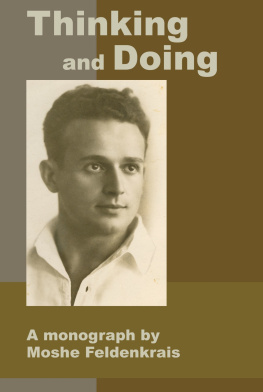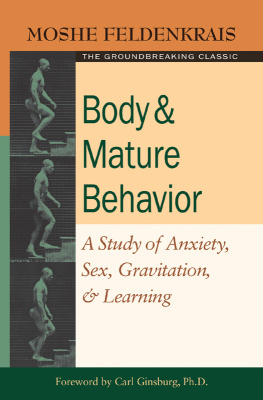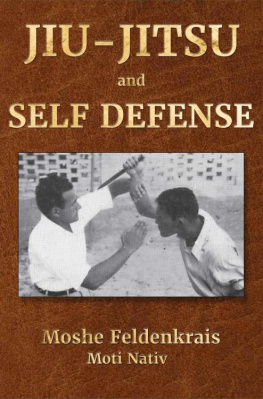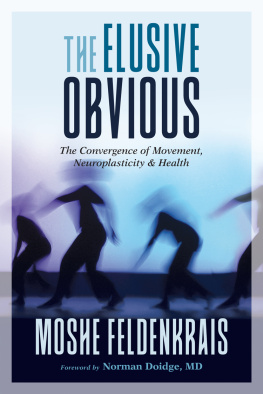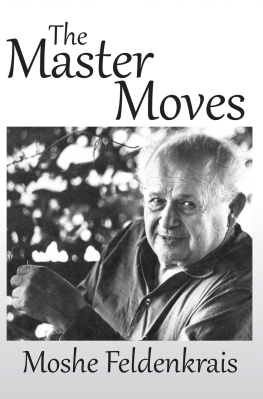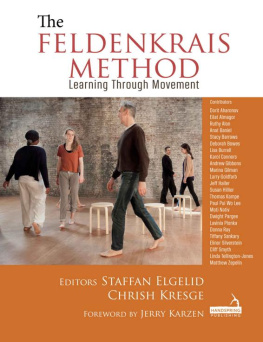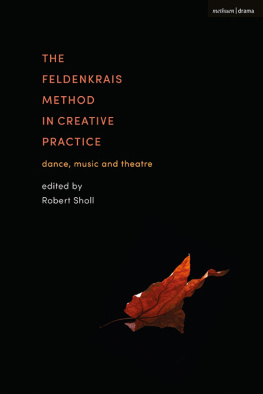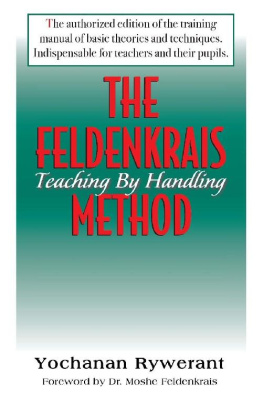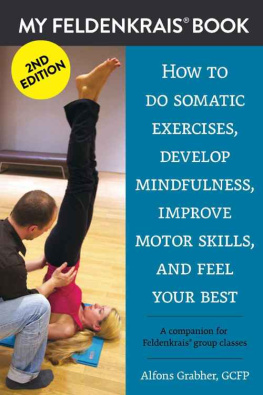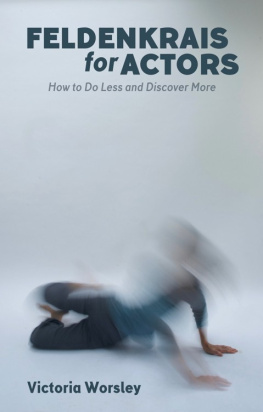Thinking and Doing
MOSHE FELDENKRAIS
Forewords by Moti Nativ and Professor Hugo Bergman
Preface by Professors Hans and Shulamit Kreitler
Translation from Hebrew into English by Reuven Ofir
Genesis II Publishing
Longmont, Colorado
AchievingExcellence.com
Feldenkrais, Moshe, 1904 1984.
The Practice of Autosuggestion by the method of mile Cou / by Moshe Feldenkrais 1929, 1977 now the Israeli Feldenkrais Guild and the Silice Family, portions gratefully used by their permission.
New foreword and archival photographs by Moti Nativ.
Copyright 2013, Genesis II Publishing, Inc. All rights reserved. No portion of this book, except in brief review, may be reproduced, stored in a retrieval system, or transmitted in any form or by any meanselectronic, mechanical, photocopying, recording, or otherwisewithout written permission of the publisher.
For information contact Genesis II Publishing, Inc.
Feldenkrais, Feldenkrais Method,
Functional Integration, and Awareness Through Movement,
are Service marks of The Feldenkrais Guild
Published by Genesis II Publishing, Inc.
P.O. Box 2615, Longmont, CO 80502
www.AchievingExcellence.com
ISBN: 978-1-884605-28-4
CIP: 2013949050
As addressed within Cou's work and in Feldenkraiss commentary, one must begin by understanding that fundamentally in matters of self-control and self-direction Imagination trumps Will. By locating the self-image as a product of self- imaging we can bypass notions of the unconscious and discern how Feldenkrais acquired one of the key pillars of his lifes work.
If, as Moshe Feldenkrais held, the unconscious is not unconscious, how did he get to that position? First, using Cous work, he immersed himself in a practical course of study on how to use the unconscious to make ones life better. Along the way he realized that the unconscious is not a thing but a process with constraints that are amenable to utilization. As such, what does that mean for notions of the sub-conscious, consciousness itself and the vast, vague domain of so-called altered states of consciousness? If we view those terms as territorial maps then the maps should correspond to their respective territories. Feldenkrais realized that the terms were less than helpful ad hoc human inventions having little pragmatic value. The processes they would map, viewed from Feldenkraiss perspective of awareness, require a radically different approach.
Dennis Leri, Feldenkrais Trainer
Contents
Introduction
The commentary by Moshe Feldenkrais, the foreword by Professor Hugo Bergman and the preface by Professors Hans and Shulamit Kreitler were translated from Hebrew into English by Reuven Ofir.
In 1929 Moshe Feldenkrais published his Hebrew translation of the book The Practice of Autosuggestion by the Method of mile Cou, originally published in English by C. Harry Brooks. Professor Hugo Bergman, first rector of the Hebrew University in Jerusalem, wrote the foreword and Moshe wrote some twenty-six pages of commentary. Moshes book was reissued in 1977, with the addition of a preface by Professor Hans Kreitler, who headed the Department of Behavioral Sciences at Tel Aviv University, and Shulamit Kreitler, Associate Professor, who lectured in the Department of Psychology at Tel Aviv University. At the invitation of Professor Kreitler, Dr. Feldenkrais delivered a series of lectures at the university.
Acknowledgements
I offer my heartfelt thanks to the Feldenkrais and Silice families for their support and for granting permission for the book to be translated and published, and the great help provided by the president of the Israeli Guild, Ramona Dekel, as she shepherded this project through the legal intricacies culminating in getting all concerned parties to sign the necessary contracts and get the ball rolling. My thanks are offered to Doron Tadmor for assisting me Introduction in my initial faltering steps in this work, and to Dennis Leri for his encouragement. To Moti Nativ I owe thanks for his unrelenting demands to stay true to the spirit and soul of Moshes writings, and for providing such a valuable postscript of his own to this work, in which he illuminates the past and provides context for the period in Moshes life during which he translated and wrote his commentary to C. Harry Brooks work on Emile Cous work.
I am grateful to Eva Laser for lovingly frowning at me and telling me I could do better, after I wrote the first and second drafts. Lastly, I offer my sincere thanks to Al Wadleigh for his generous contribution in bringing this little pamphlet to publication.
Translators note
In a learned treatise, the Roman grammarian Varro pointed out that he had discovered two hundred twenty-eight distinct meanings for the word good. The Italian proverb traduttorre, tradittore (The translator is a betrayer), by Clyde Kluckhohn, is all too correct. In this translation I have done my best to betray the author as little as possible. I hope I will be forgiven for any lapses.
Moshe worked on translating Brooks work into Hebrew some eighty-five years ago when he was in his twenties. Given the context of the times in terms of his use of Hebrew, Biblical references, and metaphors, as well as his references to people who may have faded from the collective memory, I have taken the liberty of providing meta comments and sources with the aim of offering some additional background, context, and clarity. These comments and sources are in the form of endnotes.
Reuven (Robbie) Ofir, Ph.d, P.T., Feldenkrais Trainer and former supervisor of Physical Therapy at NYU Medical Center Rusk Rehabilitation Institute, Miami Beach, Florida

The following is a translation by Reuven Ofir of the hand-written note Feldenkrais made on a copy of his 1977 publication of Autosuggestion.
The first edition of the book you are holding saw light in 1929.
Cou helped hundreds of thousands help themselves.
His idea is that imagination is more important than willpower. Imagining the good and the successful helps more than any other striving.
The Kreitler professors, pioneers in cognitive research, believe this book is more important these days than in the past.
M. Feldenkrais, Tel Aviv, Israel, 1977
Foreword
You have witnessed me in my distress, and this here is the beginning of my potency.
Moshe Feldenkrais
Autosuggestion was published at the end of 1929. At the time, it was defined as a translation of the book written by C. H. Brooks, but reading it many years after it was published singles out the uniqueness of the young translator. Moshe Feldenkrais not only translated the book, but composed and added his own observations in the two chapters you are about to read.
Looking back, we can clearly see that at that time Moshe reached a significant milestone in his life that combined his diverse activities and interests into the path that henceforth would lead him to develop his method, Awareness Through Movement.
A comprehensive reference to the contents of the book will not be complete, in my opinion, without pointing out important details of Moshes life at that chapter, the progression of which reached its peak with the translation of the book Autosuggestion.
The chapter begins in 1918 with the voyage of fourteen year-old Moshe to Palestine, landing in 1919 at the port of Jaffa. It ends in 1930 with Moshe leaving for France and starting his next chapter. In the Israeli history books these were the years of the third and fourth
Next page
